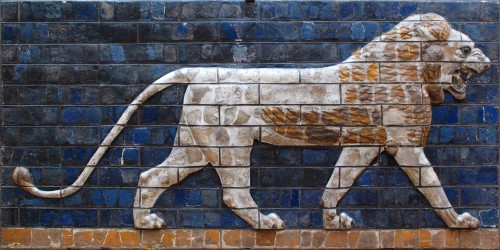In 225 B.C.E., the Greek writer Philo of Byzantium wrote On The Seven Wonders, and this early literary work highlighted the greatest man-made entities at the time. Most of the seven ancient wonders of the world are still shrouded in mystery and beauty. Yet, when it comes to these ancient wonders, the most mysterious is the hanging gardens of Babylon.
The Seven Wonders of the Ancient World are the Great Pyramid of Giza, the Statue of Zeus at Olympia, the Temple of Artemis at Ephesus, the Mausoleum at Halicarnassus, the Colossus of Rhodes, and the lighthouse at Alexandria. The Hanging Gardens, the last Ancient Wonder of the world, called Babylon its home. Babylon rose to power for the second time from 600 to 550 B.C.E., as the Chaldean Empire under the reign of King Nebuchadnezzar. His kingdom grew to be thousands of miles wide, and King Nebuchadnezzar secured his capital city of Bablyon with large walls. These protective walls were believed to be multiple feet thick and impenetrable.1
On these walls were beautiful shrubs and flowers. The legend of how these flowers bloomed over the wall began with the king. Nebuchadnezzar was proud of his creation, but one of his wives still longed for more. She mourned for her homeland on top of a mountain and wished to see the beauty of her home once again. When the king heard this, he ordered for the flowers and shrubs to be brought and then placed on top of his great wall. Exotic flowers and greenery brought a wonderful fragrance to the kingdom. The walls were irrigated using new technology. Waterwheels and pumps were installed, truly making the gardens a scientific and artistic masterpiece.2

What we can know about the Hanging Gardens of Babylon is one the most challenging of projects for modern scholars. This is due to the lack of evidence that we have about whether these gardens ever even existed in Babylon so many thousands of years ago. Much of the literature on the Hanging Gardens was written by second-hand accounts in the ancient world. Historians and archaeologists have searched for the gardens in the ruins of Babylon, but nothing concrete has been found. There are many theories about the actual location of the gardens; the leading theory comes from scholar Stephanie Dalley, a researcher from Oxford University in England. She believes that the Hanging Gardens were not in Babylon at all, but rather in Nineveh.
Dalley is an expert in ancient Mesopotamian languages. The new translations of texts from the reign of King Sennacherib of Nineveh state that there was a large beautiful garden in Nineveh that was irrigated by an aqueduct. The texts describe a water-raising screw made of bronze. The descriptions resemble that of other ancient writers’ descriptions of the Hanging Gardens, and as such, there could have been a misunderstanding in translation in subsequent years. Dalley explains that the conquering of Babylon by the Assyrians gave them the nickname of Nineveh or “New Babylon.”3
The Seven Ancient Wonders of the World still have many mysteries connected to them. Yet, the most mysterious is that of Babylon’s Hanging Gardens. Many have been skeptical that they may have never existed. Now, new evidence brings hope that more about the Gardens may yet be known, and a new understanding of the wonder of ancient civilizations may come to light.4
- Jerry Bentley, Herbert F. Zieglar, and Heather E. Streets, Traditions and Encounters, a Brief Global History. 4th ed. Vol. 1. (Boston: McGraw Hill Higher Education, 2008), 12. ↵
- Ancient History Encyclopedia, 2009, s.v. “The Seven Wonders,” by Joshua J. Mark. ↵
- Stephanie Dalley, “Garden History,” Ancient Mesopotamian Gardens and the Identification of the Hanging Gardens of Babylon Resolved, vol. 21, (February 2009): 7. ↵
- Stephanie Dalley, “Garden History,” Ancient Mesopotamian Gardens and the Identification of the Hanging Gardens of Babylon Resolved, vol. 21, (February 2009): 7. ↵



44 comments
Belia Camarena
This article is very well written, and it had a nice, story like feel all throughout. I think it is interesting that the hanging gardens of Babylon are considered one of the seven wonders of the ancient world, and scholars are not even sure it exists. I really liked that the author told the story of the king creating the gardens to please his wife. I thought this was nice.
Johnanthony Hernandez
Great article, I like how you mentioned that the king had built the gardens for his wife to remind her of home. Few people know that about the Hanging Gardens, I’ve always wondered if the gardens were a real physical location or if it was just a myth. With it being on of the Seven Wonders of the Ancient World I like to believe that it was real at one point and has been lost to time.
Samuel Ruiz
I really liked this article because I had always heard some small mention of the Seven Wonders of the World of the years, but I had never read about any of them other than the Great Pyramid of Giza. After reading about the mystery of the Hanging Gardens and their unsolved trace to Babylon, I can see now why it is such a wonder.
Evian-loren Salgado
This was a very interesting and well written article. I love how the author included how the garden was built for the king’s wife since she missed her home. Its also interesting to see how many believe the garden is in another location or believe that its myth since the gardens have not actually been found. Overall I enjoyed reading this article and learning about the hanging gardens.
Hannah Wilson
Very interesting article. I have never heard of the hanging gardens, but they sound interesting. your article helped to paint a picture of what it was like to see the gardens. I think it is kind of sweet that King Nebuchadnezzar built them just so his wife could feel more at home. It would be interesting if they found more proof of these and we could see exactly how engineers at that time were able to construct them.
Destiny Flores
I just covered the gardens briefly in class so it’s interesting to get much more background information on it. The story behind it, the King doing for his wife, is so cute. The topic itself is so fascinating because it’s labeled as one of the seven ancient wonders of the world yet there controversy that it even exists. If it does, I would really like to see it!
Crystalrose Quintero
This article was son interesting to read because we hear of the seven wonders of the world but don’t ever truly know all seven and their origins. The beautiful picture that depict the hanging garden was truly a perfect representation and brought the article to life. I found the paragraph about the validity of this wonder to be interesting. It provided the reality that this wonder has no real concrete proof in history.
Alexandria Martinez
This was a good article, it is always interesting to learn about new things and think about whether or not they even existed. It is interesting that there is so much detail and information about the hanging gardens, however people are still skeptical because there is no evidence. It could be that all the evidence was taken by past people or weather. It would be interesting to actually confirm if they actually did exist or not.
Lauryn Hyde
I find it very interesting how knowledgeable we are as a society yet there are these things that we still question, the hanging garden being one of them. This article gave a great inside on the theories as to how the garden came to be. I was drawn to this article because of the sense of mystery behind the topic.
Joshua Breard
I think that it is worth noting that The Hanging Gardens of Babylon are a big myth as there is no definitive proof of their existence. It is worth noting that because of all the questions regarding the existence of the gardens that I am even more drawn to this article. I could easily follow the picture that was painted about the hanging gardens and thus made me even more interested in them. Great job!